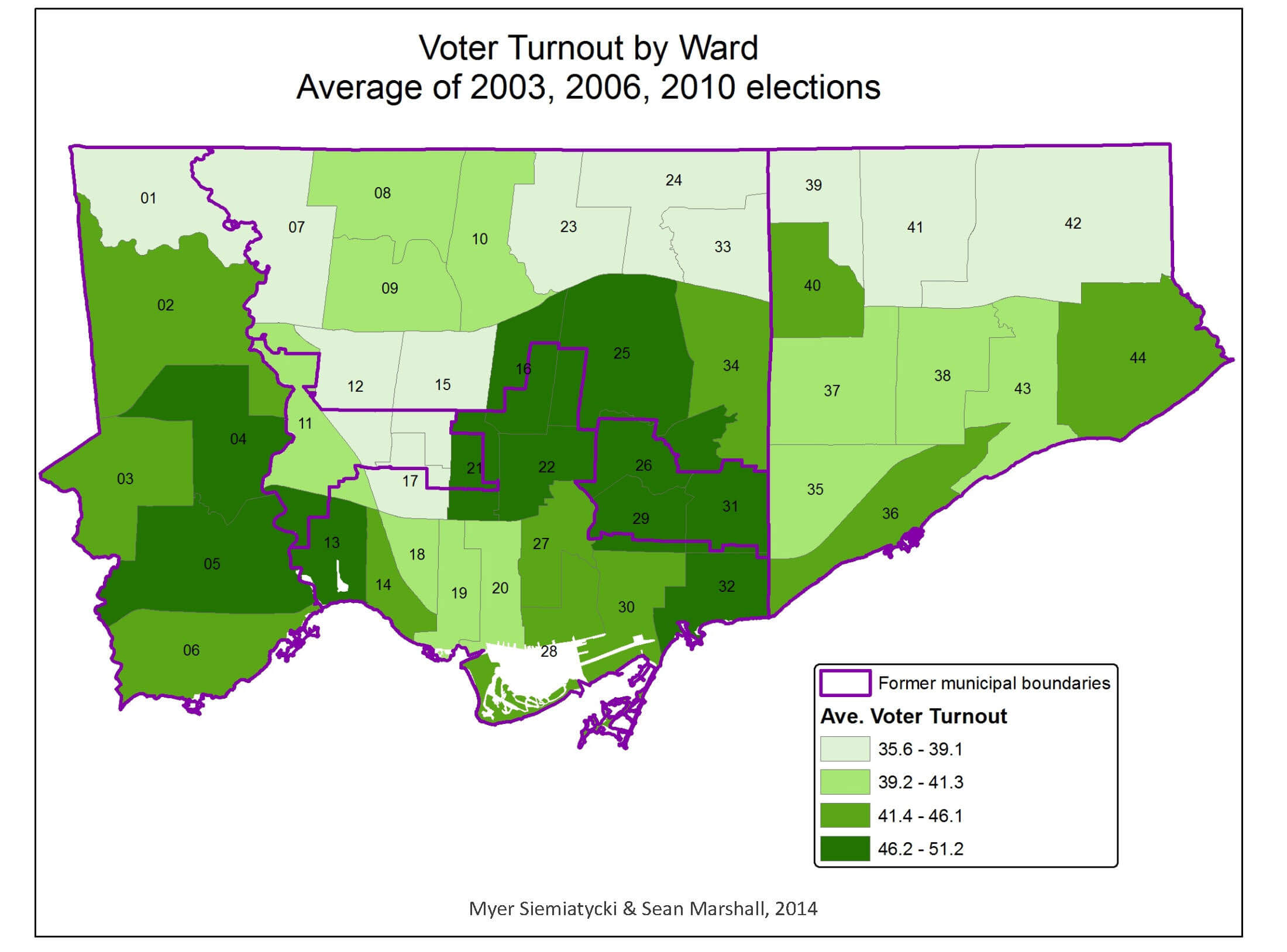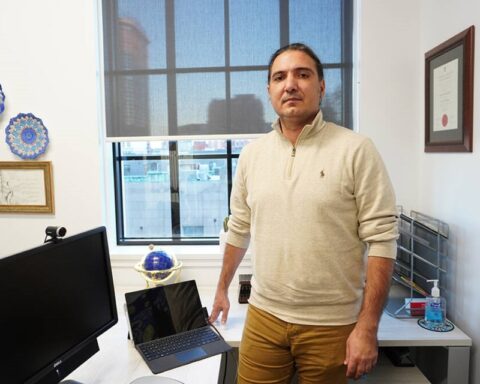It is no secret that immigrants play an important and vital role in the make-up of Canada’s fabric. There is also no dearth of research studies being conducted by academics and organizations across the country relevant to new Canadians. Research Watch will keep an eye on the studies being released and uncover key findings on a regular basis. The first installment of this NewCanadianMedia.ca exclusive looks at reports examining voter turnout in Toronto elections, changes to the Canadian Experience Class (CEC) program and the transformation of services available for Vancouver’s refugee population.
The Immigrant Vote
In 2010, when Toronto mayor Rob Ford went up against George Smitherman in the last municipal elections, many neighbourhoods heavily populated with immigrants and visible minorities voted for him. This is according to a study released in April, Who votes in Toronto municipal elections? conducted by Ryerson University professor in politics and public administration, Myer Siemiatycki and co-author Sean Marshall. But after the circus act that has gone on for months inside City Hall and the Mayor being put on blast for his alleged use of racial slurs (in November 2013 he was accused of calling a taxi driver a “Paki”, for example), the question is, will he earn the votes of newcomers and visible minorities on October 27? The verdict is still out on that one.
But at the heart of the matter lies another issue brought to light in Siemiatycki and Marshall’s study – neighbourhoods with high populations of immigrants and visible minorities have noticeably lower voter turnouts than their counterparts throughout Toronto. The study, which was based on 2003, 2006 and 2010 city elections, ranked communities like Mt. Dennis and Mount Olive/Jamestown as having the lowest turnouts, while areas like Leaside and Lawrence Park came in at the top of the list.
“Community organizing matters,” emphasizes the report, stating that a neighbourhood’s voter turnout is not fixed.
At a time when the current mayor is being scrutinized for his insensitivity toward issues faced by minorities, this may be time for these populations to get organized and get out to the polls. “Community organizing matters,” emphasizes the report, stating that a neighbourhood’s voter turn out is not fixed. For example, in the case of Regent Park, which is currently in the second phase of a major revitalization and historically has a high level of newcomer and visible minority residents, the community ranked 122nd out of 140 neighbourhoods in 2003. However, in 2006, it ranked third.

While factors like income level and household dwelling were also studied, the report highlights the most significant characteristic of neighbourhoods not showing up at the polls is the percentage of immigrants and visible minorities residing there. So, in possibly one of the most important municipal elections in recent history, no matter whether it is for David Soknacki, Karen Stintz, John Tory, Olivia Chow (an immigrant to Canada from Hong Kong herself), the incumbent Rob Ford, or any one of the other candidates, the most important thing is that visible minorities check a ballot box, period.
Why International Students Matter
Changes to the Canadian Experience Class (CEC) may have a profound impact on Canada’s ability to have a competitive edge in attracting international students, according to a recent working paper released from the Ryerson Centre for Immigration and Settlement (RCIS). First introduced in 2008, the CEC was touted by Citizenship and Immigration Canada, “to allow applicants with sufficient language skills, a Canadian post-secondary degree, and one year of Canadian work experience to access a relatively straightforward route to permanent residency.” Needless to say the program soared, and as of 2013, over 25,000 CEC applications had been processed successfully.
But in November 2013, the federal government announced some crucial changes to the program, namely, that six occupations (cooks, food service supervisors, administrative officers, administrative assistants, accounting technicians and bookkeepers and retail sales supervisors) were no longer eligible for CEC applicants. This announcement prompted the working paper, The Impact of Changes to the CEC Program on International Students, produced on behalf of Global Orient Vision, and guided by Series Editor, Harald Bauder.
“If we regard international education as a Canadian “export” – in the sense that Canadians are working to produce services offered to and paid by residents of other countries – international education services can be considered a large-scale Canadian import enjoyed by many countries and their residents.”
Above all, the report stresses one important fact, which many Canadians already know, but perhaps the government is slow to catch on to: Canada needs foreign students as much as they need Canada. Not only are international students a choice selection of human resources (they are assimilated to Canadian culture and speak one of the native languages already, the report says) but they also pay considerably more in tuition fees, helping subsidize Canadian education, and while studying here, contribute tremendously to the economy.
“If we regard international education as a Canadian “export” – in the sense that Canadians are working to produce services offered to and paid by residents of other countries – international education services can be considered a large-scale Canadian import enjoyed by many countries and their residents,” the report states. In short, internationals students are big business.
To put it into context, a 2012 Foreign Affairs, Trade and Development Canada report that looked at Canada’s more than 218,000 long-term international students indicated that they contributed $6.9 billion in expenditure and $4.2 billion in GDP, which supported 70, 240 jobs and contributed $391 million in tax dollars.
In January 2014, the federal government announced a goal to double the country’s international students by 2022 and acknowledged that in order to attract foreign students, a feasible means of obtaining permanent residence status would be needed. The RCIS report calls the CEC changes counterproductive to this agenda, particularly given that most post-secondary graduates, foreign or not, have to work entry-level positions and those are the occupations no longer available in the program.
What the working paper recommends to the government in order to remain a contender and leader in the international student marketplace: use methods like encouraging applicants to other fields, implementing quotas for particularly over-populated occupations and placing lower priority on the six aforementioned work categories versus eliminating them altogether, while continuing to improve and enhance the program and develop Canada’s international education industry.
Vancouver’s Changing Face
In two year’s time The New Welcome House will open its doors in metropolitan Vancouver. The first of its kind, regional services hub – a 58,000 square foot facility built in partnership between the Immigrant Services Society of British Columbia (ISSofBC), Henriquez Partners Architects and Terra Housing – will be a one-stop housing and support centre with 138 beds and a health care clinic for refugees with or without legal status. It is being built in direct response to the needs of refugees settling in the Vancouver area, the focus of a ISSofBC report, Refugee Newcomers in Metro Vancouver: Changing Faces and Neighbourhoods 2010-2013, issued in May 2014.
According to the report, three Metropolitan municipalities received two thirds of government-assisted refugees in 2013: Surrey (28%), Coquitlam (22%) and Burnaby (16%). While Metro Vancouver is the number one destination for refugee claimants, this is primarily due to the fact that when awaiting a decision on their claim, people stay in shelters or with family.
Perhaps what’s the most promising information from this report for Vancouver-based refugees is that the B.C. government has now contracted settlement agencies, at least until March 2015, to provide services to refugee claimants who are not eligible for traditional Citizen and Immigration Canada services.
Iran, Iraq, Somalia, Afghanistan, Bhutan and Myanmar were the top six source countries for refugees who arrived in Vancouver. While the report breaks down the individual settlement patterns of people from each of these countries, the common finding was that individuals tended to settle where others from their country were already established.
“For instance, Somali and Iraqi communities that are already present in Surrey will likely attract new arrivals from these communities,” the report states. But when that’s not the case, the other major factors that influence settlement patterns include affordable housing, public transit and access to faith communities.
In addition to the Welcome House, perhaps what’s the most promising information from this report for Vancouver-based refugees is that the B.C. government has now contracted settlement agencies, at least until March 2015, to provide services to refugee claimants who are not eligible for traditional Citizen and Immigration Canada services. However, it is unsure if the funding will continue.
Priya Ramanujam, a second-generation Canadian, is a regular contributor to New Canadian Media. A native of Scarborough, Ontario, Priya is a freelance journalist/editor, the co-founder and editor-in-chief of Urbanology Magazine and a part-time professor at Humber College. She has a passion for reporting on stories that often go untold and for working with youth on multimedia journalism projects that provide them a platform to be heard in society.





